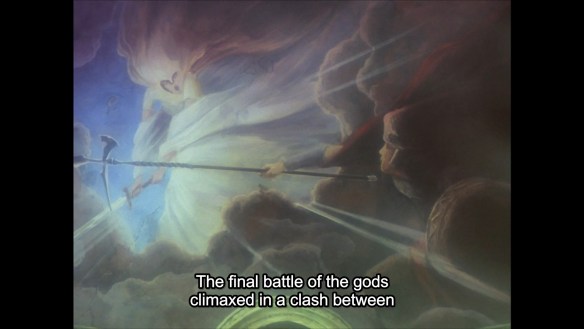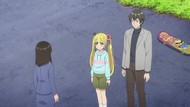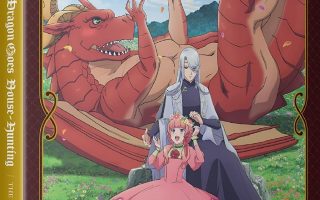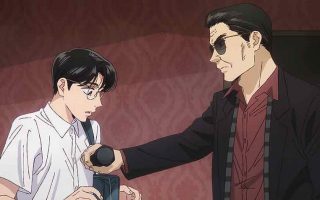Hello folks, and welcome back to Wrong Every Time. Today I’m happy to announce we’re returning to the majestic Record of Lodoss War, and checking in on the continuing adventures of Parn, Deedlit, and their motley crew of adventurers. This OVA series’ first episode offered pretty much the quintessential slice of Dungeons & Dragons adventure, prominently featuring both dungeons and dragons, and demonstrating most of the fundamental appeals of the format: exploring interesting locations, bonding with unlikely companions, applying your wits to various traps and puzzles, and ultimately facing off with mighty foes, collaborating to prove that together, you can survive and triumph over practically any obstacle.
In the early days, that was basically what DnD was all about; an exploration and battle simulator with a high fantasy coat of paint. It was up to the players to instill these basic actions with a sense of grandeur, and so they did, crafting massive fantasy vistas like our current war-torn island of Lodoss. Record of Lodoss War’s visual aesthetic is so strong, and its confidence in its mythcrafting so complete, that it has managed to maintain its place as the quintessential high fantasy anime for over thirty years, a living testament to the power of evocative art design. Let’s see how Parn’s journey begins as we return to the adventure!
Episode 2
Incidentally, yes, this is “how Parn’s journey begins” – we’re jumping immediately to a flashback, detailing the original formation of the party. The beginning of the actual play sessions that Lodoss War is drawn from involve the players actually getting their bearings regarding the system they’re playing and characters they’re embodying, a standard starting point that is likely more interesting in text format (where you can appreciate the slow settling of player and character into one) than animation. For this adaptation, they wisely opened with a self-contained adventure a little later on, which they adorned with the most sumptuous animation they could possibly conjure
It’s an anime truism that you make sure the first and last episodes of your production look best, both so the audience has a hook to keep them watching, and so they leave with a positive final impression. That initial hook could only have been more essential in the peak OVA era, where you were attempting to convince your audience to individually buy each new release
We begin with that same operatic opening monologue, detailing the great, eternal war between light and darkness. This explanatory OP is actually a nice bonus for this adaptation; it’s a useful tone-setter, lending a coating of epic significance to whatever adventures follow. “Getting the party back into the campaign headspace” is a persistent sticking point in tabletop games; opening each session with a grand detailing of the great war is a fine way to accomplish that
Of course, as I said previously, this particular scale of background drama doesn’t really fit this particular story; there’s a disconnect between the “battle between the gods” worldbuilding and the ground-level party-focused narrative that never quite closes. It’s a common problem with DnD, which tends to attract lots of people who prefer worldbuilding to storytelling – but that itself is actually changing too, as the field shifts more towards the character-focused model embodied by DnD renaissance tentpoles like Critical Role and Dimension 20. Folks drawn in by those shows will naturally seek a similar, more socially-minded experience
“Romantic in a way that almost tears at my heart.” Yep, that’s ‘80s fantasy all over
“Blazing Departure”
Gentle panning shots lead us up to a temple built into a mountainside, as we are introduced to Ghim the dwarf, our first party member
“You’re really going?” “I am. And I will find her.”
He is seeking a priestess’ daughter named Leylia. Always good to have clear character motivation at the start of a campaign – your goals or beliefs might change over time, but having an objective, a reason you’re adventuring and a goal to pursue, makes it much easier to initially integrate into your campaign world. New players will often think of fun characters in the abstract, but as in traditional fiction, characters are not stable points – they are arcs, and it helps to have some inkling of the course of that arc when you start, if only so you have ready answers to the questions “why are you traveling together” and “what do you wish to do”
Initial goals can also clarify complicated personalities; it’s easy to overreach in attempting to immediately reveal all the thought you put into your character, so having a goal to guide your interactions helps simplify things, giving you a top priority which will presumably prompt friction with others, thus in turn offering chances for other aspects of your personality to come out
“Thank you, Bramd. You fear for her as well,” the priestess says to her dragon companion. This is one thing Lodoss War excels at, and which makes criticism of its awkward scaling a little complicated – these little flourishes that imply a much broader world, offhand inclusions like this dragon which clearly has its own history and significance to Ghim’s story, all of which simply doesn’t fit in the confines of Lodoss War’s priorities. The implication of a vast, living world beyond the scope of your active narrative is an essential component of high fantasy – but the key is that this material must remain an implication, and not distract from the active drama with inessential text blocks of irrelevant worldbuilding. The curse of the fantasy writer is that you must construct an entire convincing world, yet only show your readers the elements of it that are essential for the story you are telling
Elsewhere, a maiden bathing in a pool is chased by a horde of goblins! This episode is much less fluidly animated than the last, but it still offers those carefully detailed still shots, maintaining aesthetic continuity with its predecessor
Parn leaps into battle in defense, ultimately slaying one of the goblins with a lucky spear thrust. I like how desperate this battle feels; Parn does not come off as a trained warrior, he’s clearly just a lucky and overly brave young man. Sorta reminds me of how well Grimgar illustrated the terror of being a mundane person trapped in a fantasy battle
Next to arrive is Etoh the priest, who Parn apparently knows already. This is a generally handy device; having a couple of your characters know each other previously helps give the adventure party a natural emotional core. Each party will find their own balance between pre-planned relations/conflicts and emergent drama, and I personally think the more prep, the better – such work is scaffolding, allowing you to scale greater emotional heights of emergent action
“Falis, heal these wounds.” Having a cleric in the party naturally draws the gods into the active drama, as clerics are defined by the patron who instills them with magical power. Wizards aside, most magic-users’ powers in DnD come from somewhere, which provides a natural connection with the world and opportunity for eventual drama
The villagers are angry with Parn for killing the goblin, saying they generally just run away if they’re startled. Parn, of course, wants to fight bravely and kill all of them. This is sort of an inherent issue of early DnD worldbuilding – with a bunch of overtly evil races like goblins running around, player characters are naturally defined as genocidal psychopaths who are technically right to be genocidal psychopaths, because goblins and orcs and whatnot are defined as creatures with no capacity for good within them. These design choices were presumably intended to offer gamified “fodder” enemies that the players wouldn’t feel bad about killing, but as DnD has developed into a more mature, complex storytelling vehicle, the idea that heroes just kill all non-player races because they inherently deserve it has become an awkward convention, a relic of a time when the morality of all things was decided by a stable, reductive grid. It’s thus little surprise that goblins and orcs have been humanized over time, gaining more complex moral qualities to match players seeking more complex moral dilemmas
Of course, the counterargument to this is that players need somebody to fight, and that leaning on the natural resonances of old-fashioned fantasy fiction at least provides a common language to sculpt stories in, a collective understanding that goblins are like this and bugbears are like this and whatnot. It’s a reasonable argument, particularly if you’re already accustomed to employing these fantasy conventions, but I have no such attachment; in fact, my current player character is a nervous goblin cleric who’s just trying to do her best
We check in on the goblin lair, where they are busy cackling and waving their swords. See, not a whole lot to dig into dramatically there
This episode is largely composed of still frames, but they’re such good still frames. Lodoss War is often a demonstration of how fundamentally strong art and color design can make up for a lack of fluidity; you don’t feel so bored by slow pans if those pans are revealing scenery so inviting and rich in detail
Ghim arrives at the cabin of our blonde-haired mage Slayn, intent on convincing him to join the adventure. They’re efficiently setting up a variety of motives here
“I’ve still many more books to read.” Unlike clerics and warlocks and whatnot, wizards learn spells through study rather than receiving them from the gods. If you think this might create a lopsided play environment, you’re right; wizards get more spells than anyone, can cast them more times than anyone, and can always add new ones to their collection. The only limit on their superiority is the need for expensive reagents to cast spells – but many tables discard the nitty-gritty annoyance of reagents, leaving wizards as a wholly unbalanced class that only survives as a callback to its wholly unbalanced origins
One of the great tasks of learning to play DnD is realizing that its on-book design is actually a disaster, and every table will need to retrofit the rules to their own needs
Deedlit of course still earns some luxurious character acting, as she notices the goblins marching in daylight
Parn reflects on his father, a Holy Knight of Varnis who apparently died in disgrace. A somewhat clumsy adaptation of what was presumably Parn’s player’s opening words regarding his character motivation. It’s tough to avoid some degree of ham-handed exposition when you’re initially setting up your character party, but maintaining clarity there is certainly preferable to keeping your personality secret for sessions on end, and thereby forgoing the initial, abrasive, utterly essential clashing of group personalities
He discovers his father’s armor, as clear a call to adventure as you could hope for
Nice sepia shots for these memories of his father’s exit, shot from a low angle to further emphasize Parn’s adoration of his knightly father
Parn and Etoh attack the goblin lair, only to learn from Deedlit that they’ve already left for the village
The goblin attack really tests this production to its limits; still frames are fine for exposition and scenery, but there’s a lot of aggressive non-action in these ostensible action scenes
Slayn notes that the goblins appear bewitched, and attempts to break the spell
He succeeds, and all the lesser goblins are defeated. Spellcasting is tricky this way; it’s high-impact and frequently all-or-nothing, making it tougher to balance than physical threats
Parn attempts to reason with the goblin leader, but it’s no use! This leader actually might be a hobgoblin, he’s a pretty big dude; although frankly, my mental image of goblins has been so firmly set by the combination of Magic: The Gathering and Warcraft that I’m often surprised by depictions preceding those touchstones
The goblin leader unveils his most powerful attack: standing in one spot while windmilling his sword wildly in front of him. Parn is helpless to defend against this conveniently animation-light attack pattern
But with a little help from Slayn’s magic, he wins the day
Thus our heroes set off on their great adventure, with Deedlit watching fondly from the trees
And Done
So there we have it! A tidy call to adventure defined by a mixture of noble cause and personal necessity, as Ghim heads out to retrieve the missing Leylia, while Parn discovers his destiny holds greater things than the confines of his tiny village. The animation was a massive step down from the first episode, to the point where it was at times difficult to understand what the floating action cuts were even trying to convey, but Lodoss War’s unimpeachable art design nonetheless made for a visually compelling episode. It doesn’t take much to set a party of tabletop adventurers off on a coherent quest, and this episode did a fine job of demonstrating how efficiently you can spin a half-dozen disparate dreamers into an adventuring party. Onwards to glory, friends!
This article was made possible by reader support. Thank you all for all that you do.




